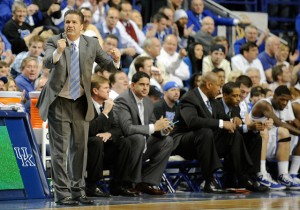Would Paying College Players Really Destroy Competitive Balance?
March Madness is in the air. Over the next few weeks the nation will be focused on the fortunes of 68 college teams. And all this focus on a supposedly amateur sport generates tremendous amounts of money. For example, in 2010 CBS and Turner Broadcasting agree to pay the NCAA $10.8 billion to broadcast these games for fourteen seasons. This money represents more than 90% of the NCAA’s revenues.
Since colleges and universities tend to be non-profit, who gets all this money? One person who seems to benefit is John Calipari, head basketball coach at the University of Kentucky. Last summer, Kentucky extended Calipari’s contract, with a new deal that will pay him $36.5 million across the next eight seasons. Contracts like this – which seem comparable to what an NBA coach might command — are somewhat surprising. As economist Andrew Zimbalist has observed, the revenues of college sports – although apparently immense – pale in comparison to what we see in professional sports. And that leads one to wonder how a coach in college can command such a salary.
To understand why Calipari is worth this kind of money, consider the seedings for the NCAA tournament. Calipari’s Kentucky team is not just a number one seed in 2012, this team is the overall number one seed in the tournament. What’s amazing about this accomplishment is that Kentucky lost three prospects to the NBA draft in 2011 (four if you count Enes Kanter, a Calipari recruit who never had a chance to play for Kentucky). This talent drain, though, was offset by players like Anthony Davis, Michael Kidd-Gilchrist, and Marquis Teague; three freshmen who might be selected in the 2012 NBA draft. Yes, Calipari has an amazing ability to attract high school players who are capable of playing in the NBA at a very young age. Given such talent, it’s not surprising that Kentucky under Calipari is consistently a contender.
One might note, though, that Kentucky’s contender status – which contributes to the revenue generated by the Kentucky program – is created by the playing talent Kentucky puts on the floor. And in a free market, this talent would be compensated for their economic contribution. The NCAA, though, is not a free market. The NCAA has passed a rule preventing NCAA members from compensating their workers (beyond a scholarship – that one-and-done players will never be able to use to complete a college education).
How does the NCAA justify such a rule? One of the big arguments offered is that paying the athletes will disrupt competitive balance. The thinking is that if colleges could pay players, only the richest schools could afford the top talent and competitive balance in college basketball would be destroyed.
There is only one flaw with this argument: the NCAA really doesn’t have much competitive balance.
A few years ago, Jim Peach – a professor of economics at New Mexico State – offered a relatively straightforward analysis of competitive balance in college sports. For NCAA basketball, Peach looked at how many different teams advanced to the Final Four over time. He found that from 1950 to 2006, thirteen schools accounted for 50% of all Final Four appearances.
Let’s update this analysis by looking at Final Four teams from 1979 to 2011. Across these 33 seasons there were 132 Final Four teams. And of these, twelve schools — North Carolina, Duke, Kansas, Michigan State, Kentucky, Louisville, UCLA, Arizona, Florida, Georgetown, Indiana, and Connecticut – accounted for 72 of these slots. Division I-A has 344 members. And just twelve members – or 3.5% of the population – account for 54.5% of all Final Four appearances.
What’s surprising about this result is the nature of the NCAA tournament. As a single-elimination contest, one would expect a great deal of randomness with respect to outcomes. And yet, the top schools are consistently able to navigate the tourney and reach the Final Four.
Part of this reflects the dominance of the #1 seeds in the tournament. Since 1979, 40.9% of Final Four slots went to a number one seed. And 82.6% of slots went to teams seeded in the top four.
So if a team can assemble a collection of future NBA players, the odds of a high seed in the tournament – and a Final Four appearance – are dramatically improved. Calipari seems to have the magic touch with future NBA players. Consequently, we should not be surprised if Kentucky reaches another Final Four.
What seems amazing – from the NCAA perspective – is that teams can achieve such consistency without paying their players. And for the rest of us, we have to wonder how paying the players would change this outcome?
Yes, Calipari would end up with less. But it doesn’t seem like the dominance of the top teams would be impacted. Teams like Kentucky, North Carolina, Michigan State, and Syracuse – the number one seeds this year — would still be great. Teams with less money would probably not be as great. And the NCAA – even with paid players – would probably look about the same.
Let me close with two more observations.
First, I think there is a sense that colleges don’t have much money to pay their players. Last fall, I addressed that very same issue. Quick summary… I don’t buy the story the college are telling.
And because I wish to embrace my inner hypocrite, if you still need help filling in your brackets (and technically, since the games started on Tuesday, this should already be done), let me recommend the following three stories at The Wages of Wins Journal:
The Ultimate 2012 NCAA March Madness cheat sheet
Arturo’s NCAA March Madness Tournament Bracket Buster



Comments